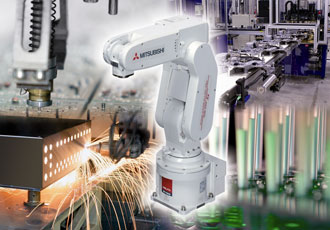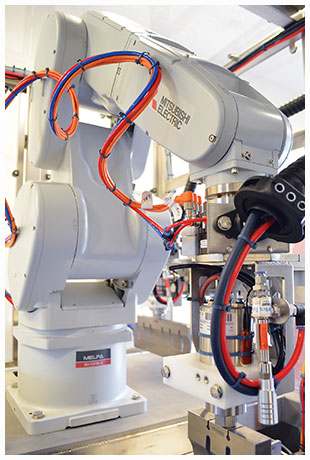Challenges and benefits that lie in ‘smart manufacturing’

The term ‘smart manufacturing’ is flying around more often than not, but what does it actually mean? Chris Evans, Marketing and Operations Group Manager at Mitsubishi Electric, here explore, what is meant by the term, and considers the benefits of adopting the concept and what challenges may lay ahead.
Many articles now discuss Industry 4.0 (I4.0) and the Industrial Internet of Things (IIoT) and defining these concepts can be difficult, however what these and other similar concepts clearly introduce is a ‘forward thinking’ mind-set and this has in some cases already led to ‘smart manufacturing’, where intelligent machines, systems and networks are capable of independently exchanging and responding to information to manage industrial production processes.
Smart manufacturing looks at the complete holistic view from customer demand and order processing, control of raw materials and ingredients to flexible and efficient plant production, whilst minimising waste, energy usage and down-time.
It sounds easy doesn’t it and what Production Director worth their salt wouldn’t immediately sanction investment to create their own smart manufacturing plant?
In fact there are instances, across many industry sectors where new manufacturing plants, or new production facilities in existing plants, have been designed from the word go to deliver a smart manufacturing concept.
Mitsubishi Electric’s Kani Factory in Japan is a perfect example of this, deploying its e-F@ctory manufacturing methodology to achieve a smart production facility.
However, in many cases the luxury of new plant is not the reality and more likely the current plant will need to be upgraded to meet the requirements and enjoy the benefits of the smart manufacturing concept.
‘Smart’ in its simplest form is about gathering data from the manufacturing process, then turning that data into information and then acting on that information. You could say that what is needed is ‘intelligent data’ from the plant in order to make decisions that improve productivity and efficiency while minimising waste, energy usage and down-time.
It is important to understand that this intelligent data has to come from the ‘sharp end’ of the process and it is clear from the advancement of sensor and actuator technology that these devices now deliver self-determination and advanced error checking as well as the traditional process information, crucial for control, production analysis and preventative maintenance alike.
The next crucial step of course is connecting various plant assets and systems together. Traditionally a production plant may have consisted of ‘islands of automation’ but in order to maximise the data gathering potential, existing infrastructures or new infrastructures must be utilised to create an architecture for data collection and management.
This is made more difficult if the production facility, as many are, is controlled by a disparate array of automation equipment from different vendors with no overall common network strategy.
Thankfully, this problem is not insurmountable, one technique is to overlay a ‘data gathering layer’ on top of the existing automation control layer to communicate with and extract data from these disparate systems. It is therefore vitally important to choose an automation vendor for this task who has a flexible open network strategy and can interface with many different network protocols.
This data gathering layer can then marshal this vital production and maintenance data and pass it on to higher level systems for analysis and decision making.
Another good thing is that the plant assets are almost certainly controlled by automation controllers such as a programmable logic controller (PLCs) and much of the data vital to deliver the smart manufacturing concept often already exists; even if this data is not currently being transferred to the higher level systems. This means that it may require minimum engineering effort to start to really understand the manufacturing process.
This is not to suggest that minimum investment will be required to deliver the smart manufacturing plant, it will clearly depend on the current infrastructure and age of the automation equipment, but a survey of what is already on plant may lead to some ‘low hanging fruit’ on the road to smart manufacturing utopia.
Productivity and efficiency improvements come from knowing exactly how the plant is currently performing and delivery of intelligent plant data via a reliable infrastructure (coupled with the convergence of business level systems with the production facility) is fundamental in this process.
It is clear that once achieved, smart manufacturing affords many benefits including the flexibility to react to customer demand, maximising plant productivity by efficient scheduling, achieving minimum down-time when changing from one product to another and also from preventative maintenance - all of which should lead to greater profitability.
Is the smart factory a step towards autonomous factories? In most cases the answer is ‘no’, in a smart factory humans will be directed to do other tasks that still require a human brain, or human touch and decision making – which, in contradiction to the naysayers actually improves the working life of the personnel in production facilities and should open up different and varied job opportunities.
Much of our concept of smart manufacturing is based on our knowledge of technology today. It is evident that technology will continue to move on at a pace, maybe now with much more direction as it begins to line up with concepts such as I4.0 and IIoT and who knows what our production facilities will look like in ten years’ time?
What will not change however is that true smart manufacturing is about having a reliable, efficient plant that can adapt swiftly and reduce errors and downtime and if manufacturers do not invest and get onboard with this concept they are highly likely to be left behind by any of their competitors that are embracing this change.
Similar articles
More from Mitsubishi
- Want a robot but don’t know where to start? 11th June 2021
- A pizza challenge for Control Freaks 22nd April 2021
- Competitive factories need to leverage the power of data 15th April 2021
- Combining user-friendliness with high performance 16th March 2021












Write a comment
No comments